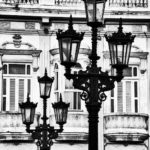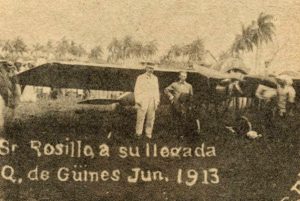It may be strange to the Cubans born during the last decades, who have experienced the national backwardness with respect to computer and communications technologies, but Cuba was a country advanced in the employment of many of the great inventions of humanity.
Railroad . In November of 1837 Cuba became the first nation of Latin America, and the sixth of the world, to have railroad. Before, it was only in Great Britain, France, Austria, the United States and Germany. The first Cuban line extended 27 km from Havana to Bejucal, and on the inaugural voyage were 70 passengers.
Phone . The first telephone rehearsals were made in Cuba in 1849 by the inventor himself, the Italian Antonio Meucci. Later, at the beginning of the 20th century, Havana was the first city to have an automatic telephone exchange with direct dialing equipment. The creation of the telephone is mistakenly attributed to the Scot Alexander Bell, who patented the invention of Meucci in the United States.
Electricity . In March 1889, one of the first electric public lighting systems in Latin America was installed in Havana, with centralized generation and distribution networks. In the following months, the electric lighting reached cities of the interior like Cárdenas, Matanzas and Camagüey.
Automobile . At the end of 1898 circulated in Havana the first car, owned by José Muñoz, Cuban representative of the French brand Parisienne. Some sources say it was in the city of Medellín, Colombia, where the first car in the region was seen a few months earlier, but in any case, the race is so tight that it is worth giving us the winners.
Aviation . In May 1913 the first international flights were made in Latin America. They were the Cubans Agustín Parlá and Domingo Rosillo, who made route between Key West, Florida, and Havana, Cuba. Likewise, in 1933, the Cuatro Vientos airplane landed in Camagüey, coming from Seville, Spain, after flying the longest distance traveled by an airplane over the ocean until that moment.
Cinema . In January of 1897 the cinematograph arrived to Havana, after passing through Mexico and Brazil, in an exhibition tour organized by the house Lumière, proprietor of the invention. By the middle of the 20th century, the Cuban capital, New York and Paris, were the cities of the world with the greatest number of cinemas.
Television . Cuba, Mexico, and Brazil were also pioneers of television and soap operas in Latin America, beginning transmissions almost simultaneously in 1950. In 1958 the first color television channel outside the United States was inaugurated in Cuba.
Humans in space . In September 1980 the Cuban Arnaldo Tamayo became the first Latin American and one of the first men to travel to outer space, aboard the Soviet Soyuz 38.
Cosas que Usted debe saber sobre Cuba (II) . (Fotos).
Puede sonarle extraño a los cubanos nacidos durante las últimas décadas, que han vivido el atraso nacional respecto a las tecnologías de la informática y las comunicaciones, pero Cuba fue un país adelantado en el empleo de muchos de los grandes inventos de la humanidad.
Ferrocarril. En noviembre de 1837 Cuba se convirtió en la primera nación de Iberoamérica, y la sexta del mundo, en tener ferrocarril. Antes, lo hubo solo en Gran Bretaña, Francia, Austria, Estados Unidos y Alemania. La primera línea cubana se extendía 27 Km desde La Habana hasta Bejucal, y en el viaje inaugural iban 70 pasajeros.
Teléfono. Los primeros ensayos telefónicos se realizaron en Cuba en 1849 por el propio inventor del aparato, el italiano Antonio Meucci. Más tarde, a inicios del siglo XX, La Habana fue la primera ciudad en tener una central telefónica automática con equipos de marcación directa. Erróneamente suele atribuirse la creación del teléfono al escocés Alexander Graham Bell, quien patentó en Estados Unidos el invento de Meucci.
Electricidad. En marzo de 1889 se instaló en La Habana uno de los primeros sistemas de alumbrado público eléctrico de Iberoamérica, con generación centralizada y redes de distribución. En los meses siguientes, el alumbrado eléctrico llegó a ciudades del interior como Cárdenas, Matanzas y Camagüey.
Automóvil. A finales de 1898 circuló en La Habana el primer automóvil, propiedad de José Muñoz, representante cubano de la marca francesa Parisienne. Algunas fuentes afirman que fue en la ciudad de Medellín, Colombia, donde se vio el primer auto de la región algunos meses antes, pero en cualquier caso, la carrera es tan apretada que vale darnos por ganadores.
Aviación. En mayo de 1913 se realizaron los primeros vuelos internacionales en América Latina. Fueron los cubanos Agustín Parlá y Domingo Rosillo, quienes hicieron ruta entre Key West, Florida, y La Habana, Cuba. Asimismo, en 1933 aterrizó en Camagüey el aeroplano Cuatro Vientos, procedente de Sevilla, España, tras volar la mayor distancia recorrida por un avión sobre el océano hasta ese momento.
Cine. En enero de 1897 llegó el cinematógrafo a La Habana, después de pasar por México y Brasil, en una gira de exhibición organizada por la casa Lumière, propietaria del invento. Hacia mediados del siglo XX, la capital cubana, Nueva York y París, eran las ciudades del mundo con mayor número de salas de cine.
Televisión. Cuba, México y Brasil, fueron también pioneros de la televisión y las telenovelas en América Latina, comenzando las trasmisiones casi simultáneamente en el año 1950. En 1958 se inauguró en Cuba el primer canal de televisión a colores fuera de los Estados Unidos.
Humanos en el espacio. En septiembre de 1980 el cubano Arnaldo Tamayo se convirtió en el primer latinoamericano y en uno de los primeros hombres en viajar al espacio exterior, a bordo de la nave soviética Soyuz 38.
Agencies/CiberCuba/Internet Photos/Arnoldo Varona/TheCubanHistory.com
THE CUBAN HISTORY, HOLLYWOOD.



 > THINGS YOU SHOULD KNOW about Cuba (II) . (Fotos). + COSAS QUE USTED DEBE SABER sobre Cuba. (Fotos).
> THINGS YOU SHOULD KNOW about Cuba (II) . (Fotos). + COSAS QUE USTED DEBE SABER sobre Cuba. (Fotos).





